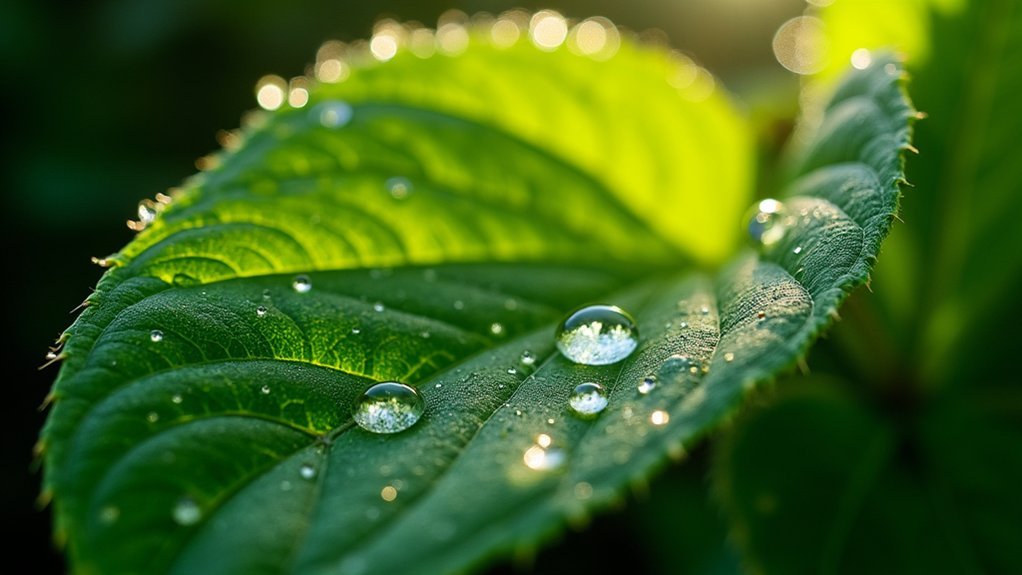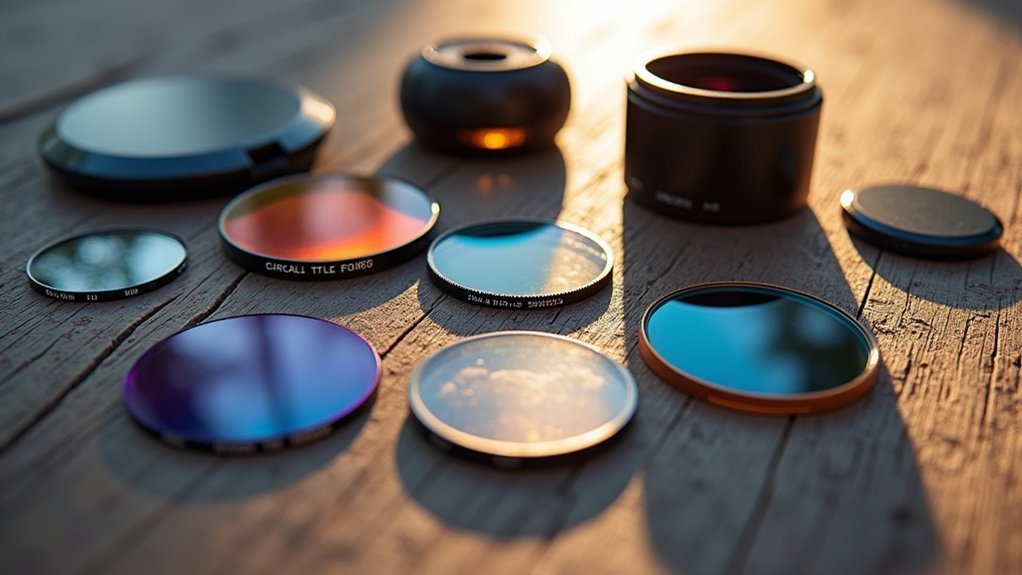Upgrade your photography with seven essential polarized light accessories: circular polarizers for glare reduction, variable polarization plates for custom light control, cross-polarization adapters for stress visualization, specialized microscope filters for detailed specimen imaging, polarized LED illumination systems for consistent lighting, rotatable analyzer attachments for precise adjustments, and filter mounting systems for versatility. These tools transform ordinary shots by enhancing colors, revealing hidden material properties, and eliminating unwanted reflections. Discover how each accessory can open up new creative and technical possibilities in your work.
7 Clever Polarized Light Accessories for Better Photos

Five essential polarizing filters can transform your photography from ordinary to extraordinary.
These photography accessories greatly reduce glare and reflections, resulting in richer colors and improved contrast that’s especially noticeable in landscape shots.
When shopping for polarizing filters, you’ll find two main types: linear and circular.
Choose circular polarizers if you’re using a modern camera with autofocus and metering systems for better compatibility.
Modern cameras deserve circular polarizers for seamless autofocus operation and accurate metering results.
For maximum effectiveness, always align your polarizing filter at a 90-degree angle from your light source.
This positioning considerably reduces off-axis glare.
When using polarizing gels, place them after diffusers or reflectors to maintain effective polarization without compromising light quality.
Experiment with these tools to create stunning visual effects like deeper blue skies and vibrant foliage that truly elevate your image quality.
Polarizing Filters for Microscope Objectives
Polarizing filters don’t just enhance traditional photography—they’re equally valuable in microscopic imaging.
When you’re examining transparent or reflective specimens, these specialized filters reduce glare and dramatically improve contrast, revealing details that would otherwise remain hidden.
To maximize their effectiveness, you’ll need to align the polarizing filters properly with your light source. Simply rotate the filter until you achieve ideal image clarity. This adjustment eliminates unwanted reflections that can obscure your subject.
For even better results, consider pairing your polarizing filters with compensators. This combination further enhances contrast in polarized light microscopy.
Remember to select the correct filter size for your microscope objectives to prevent vignetting and guarantee full coverage of your field of view.
Circular Polarizers for Enhanced Specimen Contrast

Clarity in specimen photography reaches new heights with circular polarizers. This vital photography accessory dramatically improves your specimen images by eliminating glare and unwanted reflections that often obscure important details.
For maximum effectiveness with your circular polarizers:
- Position the filter at a 90-degree angle to your light source to achieve ideal contrast reduction.
- Use high-quality multi-coated polarizers to minimize light loss while maintaining image integrity.
- Capture more vibrant, saturated colors as the filter selectively manages wavelengths.
- Improve overall image sharpness by reducing light scatter, especially important for delicate specimens.
You’ll notice immediately how circular polarizers transform ordinary specimen photos into striking scientific images with enhanced definition, particularly when photographing intricate subjects like flowers or insects.
Variable Polarization Plates for Customizable Light Control
Variable polarization plates let you fine-tune reflection control with simple rotational adjustments, giving you precise command over unwanted glare in your images.
You’ll appreciate their versatility across diverse shooting environments, from bright sunlit water scenes to urban landscapes with glass buildings.
These adaptable accessories offer real-time polarization adjustment, allowing you to quickly respond to changing light conditions without switching equipment.
Fine-Tuned Reflection Management
When dealing with challenging lighting conditions, photographers often struggle with unwanted reflections that diminish image quality. Variable polarization plates offer you customizable control over how reflections appear in your final images.
By simply rotating these high-quality optical glass accessories, you’ll achieve the perfect balance of polarization for your specific shooting scenario.
- Adjust polarization degree by rotating the plate until unwanted glare disappears from water or glass surfaces
- Fine-tune color saturation to enhance vibrancy in outdoor settings where harsh sunlight dominates
- Maintain image sharpness across the entire frame while effectively managing problematic light
- Adapt to different environments using these versatile tools that fit various lens diameters
These accessories transform challenging lighting conditions into opportunities for creating stunning, reflection-free photographs with rich colors and improved contrast.
Versatile Shooting Conditions
Professional photographers know that mastering light is essential for capturing exceptional images across diverse environments. With variable polarization plates, you’ll gain unprecedented creative control over how light interacts with your subjects.
These adjustable plates can be rotated to achieve precisely the level of polarization needed for your specific situation. When shooting landscapes, you’ll appreciate how they enhance color saturation and contrast, especially in bright, sunny conditions or near reflective water surfaces.
You can easily eliminate unwanted reflections on glass or water while preserving the details you want to highlight. Whether you’re capturing dramatic mountain scenes, serene portraits, or detailed product shots, these versatile accessories adapt to your needs.
The ability to fine-tune polarization on the fly makes these plates indispensable for landscape photography and any situation where lighting conditions might change unexpectedly.
Precise Polarization Adjustment
Unlike fixed filters that offer limited control, our variable polarization plates empower you with exact, real-time adjustments to manage light behavior.
Simply rotate the plate to align with your light source and customize exactly how much polarized light reaches your sensor.
- Perfect for landscapes – Manage reflections from water surfaces and wet foliage for dramatically improved image quality
- Enhanced visual impact – Boost contrast and enhance color saturation by selectively filtering unwanted reflections
- Versatile compatibility – Works with various lens sizes across different photography genres
- Complete creative control – Fine-tune polarization effects to achieve your artistic vision without switching equipment
These innovative plates deliver unprecedented precision, allowing you to capture exactly what you envision while eliminating distracting glare that can diminish your photographs.
Cross-Polarization Adapters for Birefringence Imaging
Cross-polarization adapters feature various filter mounting systems that let you quickly attach polarizers to your camera and light source for ideal birefringence capture.
You’ll find these adapters invaluable for stress pattern visualization, revealing otherwise invisible internal tensions in glass, plastics, and crystals under polarized light.
In materials testing applications, cross-polarization setups help you identify structural weaknesses, analyze composite materials, and verify manufacturing quality through the distinctive color patterns they produce.
Filter Mounting Systems
The fascinating world of birefringence imaging becomes accessible with specialized filter mounting systems designed for cross-polarization techniques.
These innovative setups allow you to align polarizing filters at precise 90-degree angles, revealing hidden structures in transparent subjects that you’d otherwise miss in conventional photography.
- Mount your polarizing filters in a stable configuration to eliminate unwanted reflections and dramatically enhance contrast in minerals and crystals.
- Calibrate your filter positioning carefully—even slight misalignments can reduce the clarity of birefringence effects.
- Look for systems that offer smooth rotation capabilities, allowing you to fine-tune the cross-polarization angle.
- Consider modular mounting systems that accommodate different lens diameters for maximum versatility across your equipment.
With proper filter mounting systems, you’ll access a new dimension of photography that’s particularly valuable for scientific documentation and artistic exploration.
Stress Pattern Visualization
Once you’ve mastered proper filter mounting, you’ll want to explore one of the most engaging applications of polarized photography: stress pattern visualization. Cross-polarization adapters transform ordinary objects into colorful stress maps by placing subjects between two polarizers oriented at 90° angles.
| Material | Camera Accessories | Results |
|---|---|---|
| Plastics | Cross-polarizer | Vibrant rainbow patterns |
| Glass | Tripod for low light | Clear internal stresses |
| Polymers | Macro lens | Detailed structural analysis |
You’ll need steady support for the long exposures often required in birefringence imaging. Proper alignment is essential—even slight misalignment diminishes the effect. In low light conditions, these adapters reveal internal structures invisible to the naked eye, creating both scientifically valuable data and artistically striking images. The technique works particularly well with transparent items under stress, revealing their hidden optical properties.
Materials Testing Applications
While photographers often focus on artistic applications, materials scientists have transformed cross-polarization adapters into essential diagnostic tools.
These photo accessories reveal invisible properties when transparent materials are placed between polarized light filters, helping you identify structural weaknesses before catastrophic failures occur.
Using cross-polarization for materials testing offers several advantages:
- Enhanced visibility of stress patterns in glass, plastics, and other transparent materials
- Detection of hidden defects and inclusions that remain invisible under standard lighting
- Non-destructive analysis of material properties at the microstructural level
- Adjustable wavelength settings for optimizing contrast and clarity in different materials
You’ll find these specialized polarized light techniques invaluable when examining material integrity in laboratory settings, whether you’re analyzing geological samples or testing industrial components.
Polarized LED Illumination Systems for Consistent Results
Because traditional lighting setups often struggle with unwanted reflections, polarized LED illumination systems have emerged as game-changers for photographers seeking consistent results.
These innovative systems dramatically enhance image clarity by reducing glare and boosting color saturation in your photographs.
Polarized lighting elevates your images from ordinary to extraordinary, eliminating distractions while intensifying color depth.
You’ll appreciate the adjustable polarizing filters that give you unprecedented creative control over both direction and intensity of light.
Position them precisely to eliminate unwanted reflections while maintaining the highlights you want to preserve.
Most systems offer dimming capabilities and color temperature adjustments, allowing you to customize your lighting for any situation.
For peak performance, guarantee proper alignment between the polarizing filter and light source.
These energy-efficient solutions work beautifully in both studio and field settings, providing the versatility you need for professional-quality images in diverse environments.
Rotatable Analyzer Attachments for Precise Light Manipulation

Rotatable analyzer attachments represent the pinnacle of polarization control for photographers seeking exceptional image quality.
These versatile accessories mount directly onto your lens, allowing you to adjust polarization angles with precision while maintaining ideal light conditions for your photography.
- Eliminate unwanted glare and reflections by aligning the analyzer with your light source, instantly producing richer colors and improved contrast.
- Create unique artistic effects through deliberate manipulation of shadows and highlights.
- Enhance landscape photography with more vibrant skies and detailed foliage.
- Easily fit these attachments to existing gear without carrying additional bulky equipment.
You’ll appreciate how these analyzers transform challenging lighting situations into opportunities for creative expression, giving you complete control over how light interacts with your subjects.
Frequently Asked Questions
What Are the Best Accessories for Photography?
You’ll enhance your photography with polarizing filters, external flashes, remote shutter releases, tripods, and lens cleaning kits. Each accessory serves specific purposes, from reducing glare to ensuring stability during challenging shots.
How Do I Get the Best Lighting for My Photos?
You’ll get the best lighting by shooting during golden hours, using reflectors to fill shadows, and positioning polarizing filters at 90° to light sources. Don’t forget diffusers to soften harsh light when needed.
How Do I Make My Photos Look Like Professional Photos?
To make your photos look professional, use polarizing filters to reduce glare, incorporate a tripod for stability, experiment with creative lighting, clean your lenses regularly, and practice proper composition techniques. You’ll see dramatic improvements.
Which Type of Light Is Best for Photography?
Natural light is best for photography, especially during golden hour. You’ll capture soft, flattering images with vibrant colors. However, artificial lights with diffusers give you more control in challenging conditions.
In Summary
You’ve now got the tools to transform your photography with polarized light. Whether you’re capturing microscopic details or studying specimen birefringence, these seven accessories will elevate your results. Don’t underestimate the power of controlled light—you’ll notice enhanced contrast, reduced glare, and stunning visual effects immediately. Try incorporating these polarizing tools into your workflow and watch as your images reach new levels of clarity and impact.





Leave a Reply